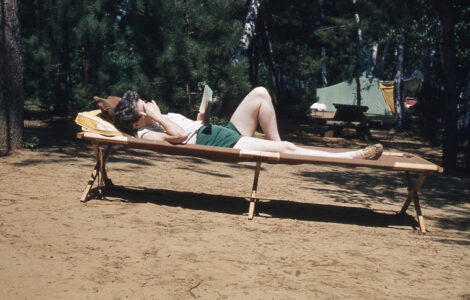How we go chasing waterfalls

The writer observes a waterfall from a respectful distance. (Provided photo)
There is a specific type of frustration that only comes from watching other people behave with flagrant disregard. On a little hike last Saturday, my partner and I got a taste of it.
Having wandered a few miles through the woods to an incredible veil waterfall, we were standing on a vista overlooking the yawning chasm below when a group of eight boys came scrambling up from a section of trail that was very clearly marked “CLOSED,” even sporting a rope to bar passage. I have heard stories of people taking this path in winter and getting hopelessly stuck at the bottom because of their lack of preparedness and awareness. These kids did make the hike back up, barely sticking to thin dirt and wet rock in their tennis shoes. Ignoring even the concept of social distance, they came right up to us, breathing hard, shouting about “how crazy it was down there, bro.”
Trying to regain a little peace and quiet, we made for the other side of the gorge. The trail led to a bridge that crosses the stream just above the falls; you could see right off the edge where the water pitched away into the void. We decided to get a little closer look, so we left the trail and carefully wandered through some of the season’s last snowbanks until we were able to get an incredible view out over the edge. After grabbing some photos, we noticed the group of boys had found the bridge. Seeing us, they promptly left the trail and smashed through the underbrush to get to where we were. Again, entirely ignoring the notion of social distance, they all but pushed past to find the view for themselves.
The whole event set me spinning, but as we hiked out and debriefed the experience, my partner made an observation that I latched onto: People tend to copy the behaviors of others, especially in wild places. At first, I considered that sentence at face value. Those kids had seen us off-trail and had taken none of the precaution we’d taken to get to the same spot. But then I had to consider the fact that while watching those ill-prepared kids come back up a closed trail, I had suddenly wanted all the more to go down and check it out for myself. What made that the case? Was I inspired by what they’d done? Was my interest piqued when I heard about what might be down at the bottom of that steep descent? Was I competing with them, subtly, somewhere in the back of my mind? More to the point, why was I tempted to ignore an obviously stated warning just because I saw someone else doing it? Someone, it might be added, that I stood in rather immediate judgment of for their lack of preparedness and general disregard for the integrity of the trail, their own safety or the well-being of others. Either way, I didn’t have a ready answer to any of these questions. While I didn’t ultimately follow in their footsteps, they wound up following mine.
I have found that people are often quick to point fingers and slow to turn that finger back on themselves. I am no exception to this rule. For many people who are comfortable in the woods, or who turn to them for a sense of exploration and adventure, the idea of “best practice” exists on a spectrum. Is it inherently wrong to wander off trail? I don’t think so. Is disregarding the work done by professional land managers a good idea? I think not. Being governed by rules and regulations while you’re out exploring wild places might seem contrary to the notion of freedom in the forest. It might seem like a temporary impediment to your good time, but setting a good example is critical. It can be difficult to bear this in mind consistently because, for many of us, our local trails feel like home. They’re places we know like the back of our hand and where we feel we can act freely. Much like in your own living room, it’s easy to get complacent. In truth, however, unless it’s on private land, everyone has the same right to access these places.
As the present pandemic continues, more scrutiny is being observed as to how people use the land, where they’re coming from, and what they do when they’re there. This concern was embodied in what I saw while hiking on Saturday, but this also served as a reminder that we need to apply the same scrutiny to our own actions, pandemic or not. Impact on wild places is not negated simply because you visit them more often. As people seek to spread out more and avoid crowded trailheads, it is important to remember our responsibility to the wild places we call home. Wherever and however we choose to recreate outdoors, we should be intensely aware of our impact and the example we set, even if it seems innocuous at first glance. After all, even if we think we’re conducting ourselves with care and diligence, it’s impossible to know who might try to follow in our footsteps and contribute to damaging places we love.


